Hyliion ERX Hypertruck combines the best of two emissions-reducing worlds
It’s now pretty obvious that decarbonizing longhaul trucking in Canada won’t be cheap or easy. Battery weight, limited range, and the extraordinary cost of privately owned charging infrastructure will likely keep large-scale battery-electric vehicle (BEV) adoption at a crawl at least until the end of this decade.
Hydrogen fuel cells and internal combustion engines also look promising but are probably further away from commercialization than BEVs — and expected to cost as much as 30% more than those vehicles.
Is there a middle step we can take now, somewhere between diesel and fully electric, that meets industry needs while checking all the environmental boxes? It might be Hyliion’s Hypertruck ERX.
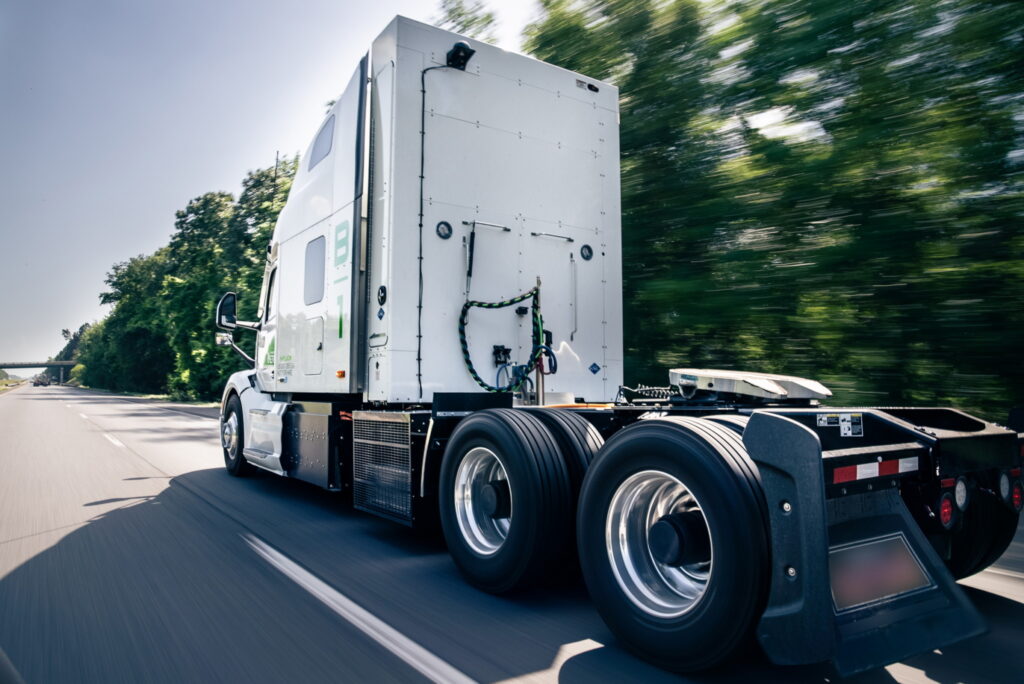
ERX is a fully electric, battery-powered drivetrain kept charged by a natural gas generator, sometimes called a range extender. It represents a significant step toward decarbonization using an energy source that’s already cleaner and less expensive than diesel. This solution essentially offers unlimited range, and there’s no upfront infrastructure cost.
The truck I drove this November in Austin, Texas, was a pre-production version, but I was told it’s better than 90% production-ready. The company is running controlled fleet trials now, and after evaluating fleet feedback, expects to begin production late in 2023 or early 2024. At this point, there are no Canadian fleets involved in those trials.
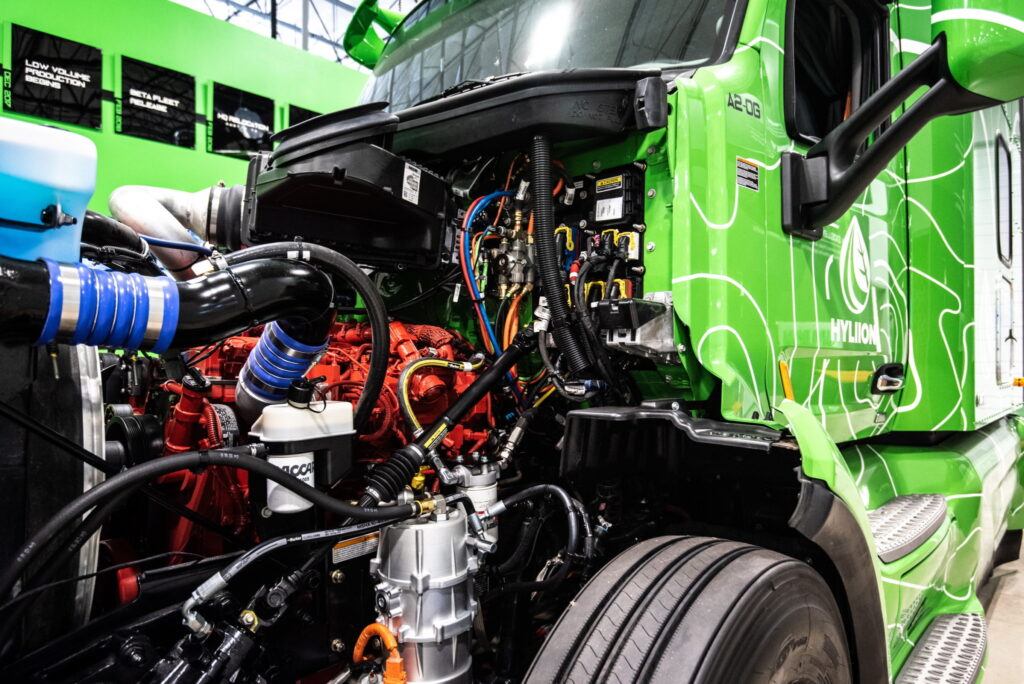
What is the ERX Hypertruck?
The ERX powertrain is a simple concept, but the execution is pretty complex. The truck has tandem drive axles, each powered by an independently controlled electric motor with a two-speed gearbox. The motor/gearbox assembly is mounted on the front of the differential housing where we’d typically find a driveshaft.
The motors are powered by a pair of saddle-mounted batteries charged by a Cummins ISX12N natural gas engine with no direct link to the drive axles. There’s an electric generator mounted on the back of the engine where the transmission usually goes. And the engine is fueled by four compressed natural gas storage tanks with a diesel-gallon-equivalent capacity of 175 US gallons (662 liters).
That fuel supply gives the truck a range of about 1,000 miles (1,600 km). Running only on batteries, with the generator shut off, it has a range of about 75 miles. That’s enough to operate in noise abatement areas or at night in areas where diesel engines are frowned upon.
The charging system is optimized to keep the engine running in its most fuel-efficient range most of the time while charging. Unlike a direct-drive diesel, this engine isn’t subject to the high transient cycles associated with upshifting, downshifting and maintaining road speed. It runs mostly at a fairly steady speed, where the wear and tear and fuel consumption are minimal.
There’s a lot of computing going on to maintain the optimal battery charge. Since the truck also takes advantage of regenerative braking, the engine-powered generator will stand down and let momentum charge the batteries. It has a predictive charging system where, through terrain mapping, the truck knows ahead of time where charging opportunities can be found. So it will let the battery charge drop even lower than usual to capture as much free energy as possible.
Conversely, if the driver plans to operate in battery-only mode, the system can be preset to maximize the charge ahead of time for optimized range.
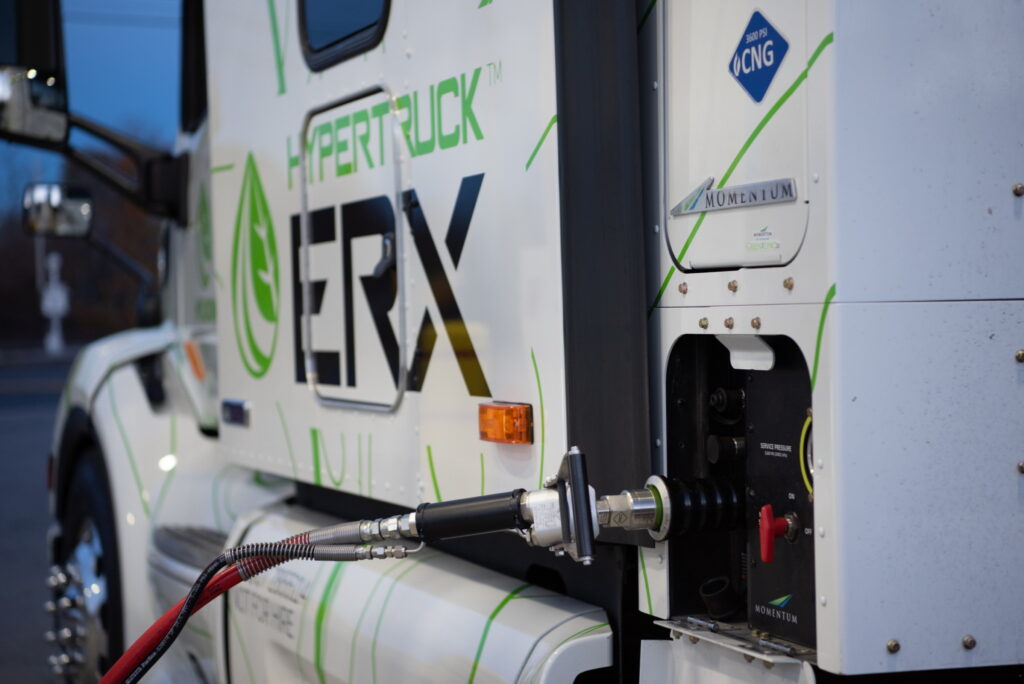
How the ERX Hypertruck works
Hyliion Founder and CEO, Thomas Healy, gave me a walkaround tour of the truck and accompanied me on the drive, giving me lots of opportunity to ask questions. He answered most of them but was mum on a few points. In fairness, it’s still in development, so some spec’s might change before production begins.
When asked about weight, he said it was lighter than a full BEV but heavier than a diesel.
The ERX powertrain system features Meritor’s Blue Horizon 14Xe integrated drive axles as the standard position propulsion and regeneration hardware.
It has four compressed gas tanks (175 DGE) mounted behind the sleeper, which Healy said could be scaled down to three or two (65 DGE) to save weight if required.
The Cummins ISX12N is a stock engine with few modifications. It has the standard maintenance-free three-way catalyst aftertreatment system, and already meets the California Air Resources Board (CARB) and Environmental Protection Agency’s (EPA) 2027 Low-NOx emissions standard of 0.02 g/bhp-hr, which is 90% lower than the current North American EPA standard for diesel.
Accessory drives such as the power steering pump, air compressor, and cooling fans are all electric. The electrics demand little additional maintenance, while the ISX12N requires things like the usual oil changes and spark plug changes at specified intervals. The truck also has an all-electric HVAC system that is essentially maintenance-free for idle-free and noise-free operation.
If the truck is sitting for an extended period, drivers can manually start the generator engine and idle for a spell (it is a certified clean-idle engine) to charge the batteries.
The truck was an off-the-shelf Peterbilt 579 with few modifications to the cab or driver interface. Rather than controlling the transmission and engine braking functions, the Paccar shifter paddle on the steering column makes forward and reverse shifts and controls the level of regen braking intensity.
Our truck had a prototype tablet display to show the battery state of charge, and other pertinent details, but that will eventually be integrated into an in-dash display with yet-to-be-determined functions. The driver will likely be able to control some aspects of the charging system and battery-only operation, but not all.
The truck we drove sat on a 250-inch wheelbase.
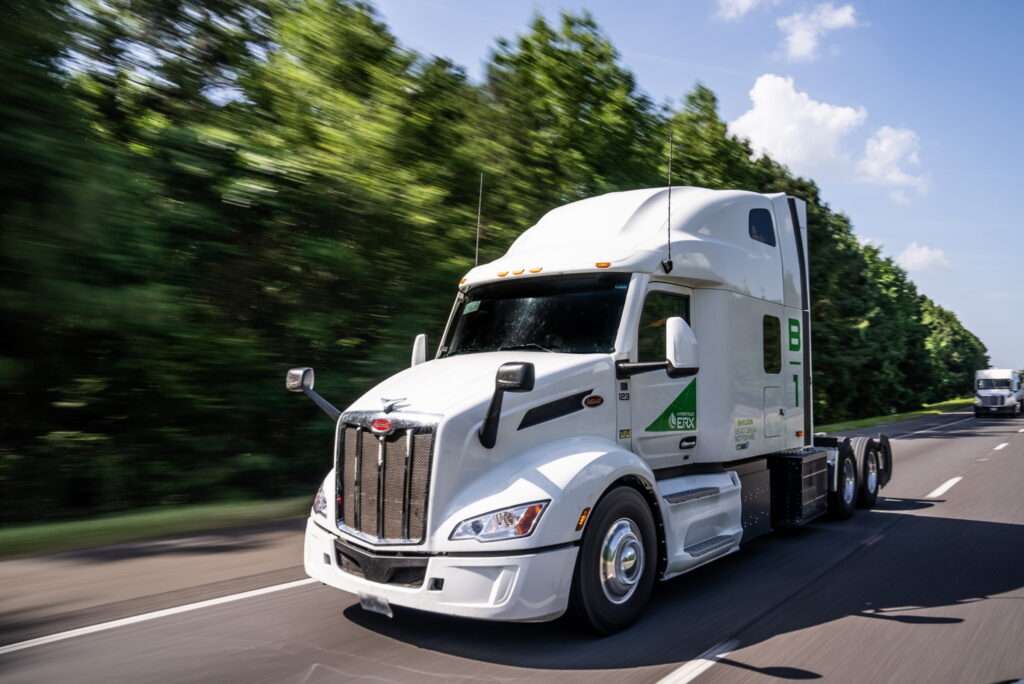
Driving the ERX Hypertruck
I wish I had something more exciting to offer, but the ERX Hypertruck drives just like any other Peterbilt 579 — with a couple of notable exceptions. It’s really quiet inside, even with the range extender engine running, and with a total of 670 hp at the wheels, it pulls better than almost any truck I have ever driven.
Drivers aren’t fond of natural gas engines, but they love battery-electric trucks for their power and get-up-and-go. Here’s the beauty of the ERX. In a typical driving scenario, flat ground, open road, the truck needs about 125 to 150 hp (like almost any modern aero truck) to maintain 65 mph (105 km/h) or so. The natural gas engine pushes about 200 hp through the generator and into the batteries. There’s a positive flow of electricity to the batteries anytime the state of charge is between 50% and about 80%.
However, if the driver gets on the throttle for a climb or a passing maneuver, output isn’t limited to the natural gas engine’s 400 hp. The driver has a full 670 hp and gobs of torque under foot.
When accelerating up a freeway onramp, as I did at one point, I could feel the motors changing gears, though my co-pilot Thomas had to point it out as it was happening. As one of the two drive motors broke torque and shifted to high gear, the other motor kept powering the other drive axle. When the first shift was complete, the second motor/gearbox shifted to high gear, and we kept accelerating.
On the other end of the electric spectrum, regen braking was as strong or stronger than even a diesel engine brake. I was able to manage the intensity of the braking (energy capture) with a control on the steering column, from Position 1 (mild) or Position 3 (full). In a skilled driver’s hands, this could easily be a one-pedal truck, with almost no need to ever touch the brake except to hold the truck still at a traffic light.
The in-cab noise level in battery mode was about 10 decibels quieter than a diesel. The difference is about the same as a typical diesel at highway speed compared to a fairly nice passenger car. It was a bit louder with the generator engine running, but that was less obtrusive than a reefer engine. In fact, it was a lot like a reefer engine, cycling on and off and changing speed with charging demand. The difference was the sound was coming from the front rather than behind the cab.
It was also a bit odd accelerating and decelerating with no difference in the sound of the engine. It ran at a fairly constant speed regardless of what the truck was doing. I think most drivers would get used to that after a day or two of driving and ERX.
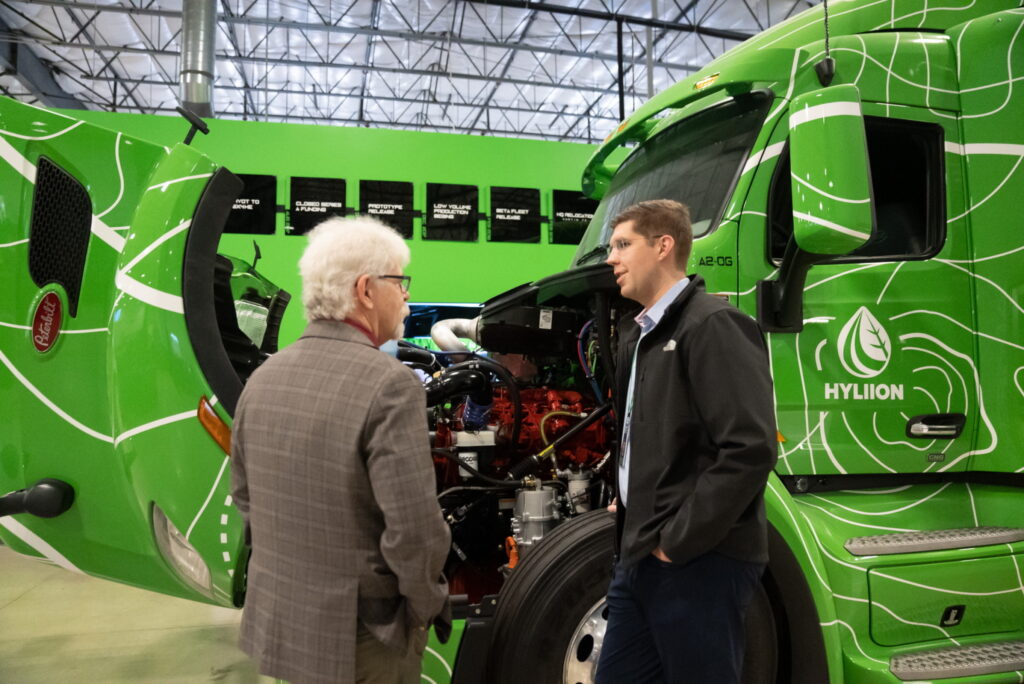
Renewable Natural Gas
I saved what I think is the best part of this truck for last. The truck also runs on renewable natural gas, which is a form of methane recovered from sources such as landfill sites, manure ponds, and biomass digesters. Landfill gas and manure pond gas include potent forms of methane and are greater contributors to global warming than carbon dioxide, or CO2, which is one of the harmful byproducts of diesel fuel combustion.
By capturing and burning that methane as a fuel to produce electricity, we not only eliminate the CO2 produced by diesel fuel when used to power a truck, we also take that more potent methane out of the waste stream and prevent it from escaping to the atmosphere. This results in renewable natural gas having a negative carbon intensity.
Hyliion makes a big deal out of using RNG. That’s maybe a bit disingenuous unless they are tanking up at a dedicated RNG producing facility. In truth, RNG is sold to natural gas distributors, where it displaces a certain amount of fossil natural gas in those pipelines. In Canada, about 8% of the natural we burn is RNG, but that number could be grown substantially. It’s about 32% in the U.S. by some estimates. In California, for example, more than 90% of the natural gas consumed for transportation fuel is RNG.
The other big positive Hyliion’s ERX Hypertruck has going for it is that it’s here. Now. No waiting a decade for the grid to catch up to demand. No need to upgrade truck terminals with high-voltage power supplies, and the fueling network is already well established along most busy truck corridors.
Have your say
This is a moderated forum. Comments will no longer be published unless they are accompanied by a first and last name and a verifiable email address. (Today's Trucking will not publish or share the email address.) Profane language and content deemed to be libelous, racist, or threatening in nature will not be published under any circumstances.
Hello, I am curious about efficiency. I was thinking that having to convert energy 3 times would be less efficient than a transmission in direct. I understand for lets say.. city driving, the engine to generator to motor set up would be best, but on long haul cross country, a transmission in direct would be more efficient for that kind of travel.
Thanks a lot Jim, this has to be the best researched article till date on Hyliion. Packed with information and very well written.